All 31 entries tagged Token
No other Warwick Blogs use the tag Token on entries | View entries tagged Token at Technorati | There are no images tagged Token on this blog
February 09, 2024
A “Vota Publica” token of the usurper Nepotian?
Among the numerous Roman tesserae and coin-like objects that have been emerging on the market in recent years is an unusual specimen made of bronze, which can be associated to the “Vota Publica” token series (AD 305/306 – c. late fourth century) (Fig. 1). As is comparatively known, this late Roman emission consists of two clusters displaying the portrait of a Roman emperor or an Egyptian deity (Serapis, Isis, Hermanubis) on the obverse – hence they have been respectively named as “imperial” and “anonymous” series – which share a set of ritual scenes referring to different aspects of Egyptian and Isiac cults on the reverse, mostly accompanied by the legend “Vota Publica’” (= “public vows”).
On the obverse of the focused token is a bare-headed, draped, male bust facing right, with a pointed nose, a short, grape–shaped beard, and a coiffure with straight hair except for a row of curls on his forehead, which is accompanied by the legend DEO SE-RAPIDI in the dative case (“to the god Serapis”). This portrait has none of the typical features of Serapis iconography, such as a mature look, a voluminous beard, and above all a grain measure called a modius or kalathos worn as a headdress (accompanied by a radiate crown in some variants), which regularly typify the Egyptian god on the tokens from the “anonymous” group (Figs. 2-3). It should thus represent a different male figure which is not otherwise identified by the legend. On the reverse is a draped (and veiled?) female figure standing front, head turned l., holding uncertain objects in each hand, accompanied by the peculiar legend VOTA P-VBLICA. These two obverse and reverse types are unrecorded and are therefore worthy of closer examination.
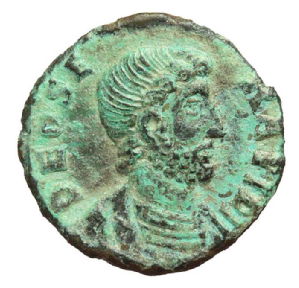 |
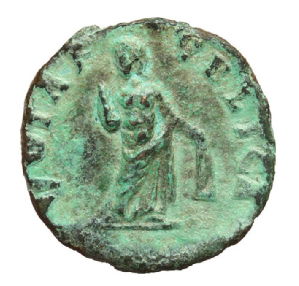 |
Figure 1: Æ “Vota Publica” token (15mm, 1.59g, 11h). Artemide Aste 19.1E, 20-21 October 2012, lot 381. Reference: L. Bricault & C. Mondello, Isis Moneta. The ‘Vota Publica’ tokens from late antique Carthage and Rome (forthcoming), cat. no. E169.1.
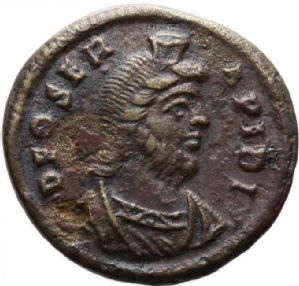 |
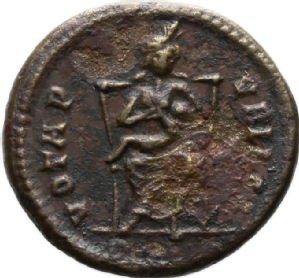 |
Figure 2: Æ “Vota Publica” token (19mm, 2.93g). Ashmolean Museum (inv. HCR71378, Douce coll.). Reference: L. Bricault & C. Mondello, Isis Moneta. The ‘Vota Publica’ tokens from late antique Carthage and Rome (forthcoming), cat. no. S83.1.
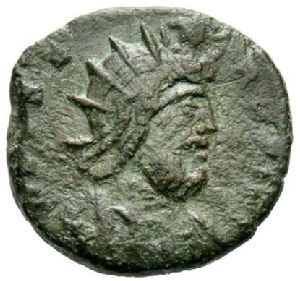 |
 |
Figure 3: Fig. 3: Æ “Vota Publica” token (18mm, 2.52g). Gorny & Mosch 278, 21.04.2021, lot 3851. L. Bricault & C. Mondello, Isis Moneta. The ‘Vota Publica’ tokens from late antique Carthage and Rome (forthcoming), cat. no. S86.3.
The specimen, with a module of 15mm and a weight of 1.59g, was offered for sale in an online auction about ten years ago but remained unsold. In the relevant auction catalogue, the token was given as a very rare (genuine) piece (“RRR”). As for the imagery, the commentator identified the obverse portrait as the emperor Julian (AD 361-63) and described the female figure on the reverse as Isis, holding a sistrum in her right hand and situla in her left (sic). Nevertheless, this description does not appear to be supported by the evidence provided by the official coinage nor by the obverse and reverse depictions occurring on the surviving “Vota Publica” tokens.
Julian’s portrait as Augustus (AD 361-363) is commonly figured on coins in the guise of a draped and double–pearl diademed bust, with a mostly long and pointed beard, either wearing military clothing or consular garb; with such features it also recurs in some of the “Vota Publica” token issues, where the ruler is clearly identified by the legend D N FL CL IVLI-ANVS P F AVG or FL CL IVLIA-NVS P F AVG. Inspired by the Greek philosopher’s model, the short or long-bearded portrait of the last ruler of the Constantinian dynasty constituted a “revolutionary” innovation with respect to the iconographic tradition of the new clean–shaven portrait of the emperor in late antiquity which was established by Constantine I (AD 306-337). However, the Julian-type portrait of the Julian type failed to prevail over the Constantinian imperial portrait model which, inspired by Augustan and Trajanic imagery, was later followed by most emperors in the West and East across the fourth and fifth centuries.
Although the male portrait in Fig. 1 is also bearded as in the case of Julian, its general features do not match the latter’s coin portraiture. Closer parallels can instead be found in the coin images of another fourth-century bearded ruler, the usurper Nepotian.Son of Virius Nepotianus and of Eutropia (half-sister of Constantine I), seemingly born after the dynastic purge by the sons of Constantine I in the summer of AD 337, Nepotian was hailed emperor by a mob on 3 June 350 after the revolt of Magnentius, and ruled the city of Rome as usurper for twenty-eight days, before being killed by his rival Magnentius’ magister officiorum Marcellinus. As a usurper, he struck coins in his own name (as well as in the name of Constantius II), the production of which was limited to the Roman mint and only consisted of two denominations, that is solidi and large billon AEs. On the two “Urbs Roma” and “Gloria Romanorum” series, the portrait of Nepotian occurs either bare-headed or rosette-diademed, with an oblong face shape, a peculiar hooked nose, a short beard, and curly or straight hair with a mostly wavy fringe.
As can be seen in Figs. 4 and 5, the vultus of Nepotian and general features of his coin portrait seemingly have some affinities with the bearded bust on the obverse of the focused “Vota Publica” token.* If this assumption is correct, such a relation may suggest that the former inspired or served as a model for the latter, although it must be said that there are some slight differences which are probably due to a different engraving style. On the other hand, in this author’s opinion, no remarkable parallels can be found with the few bearded portraits of the emperors or usurpers of the West and East on coins issued since the post-Tetrarchic period (e.g., Martinian, Vetranius, Procopius, Eugenius, Maximus of Hispania, Joannes), nor with those on Roman medallions and “contorniates” from the fourth and fifth centuries AD.
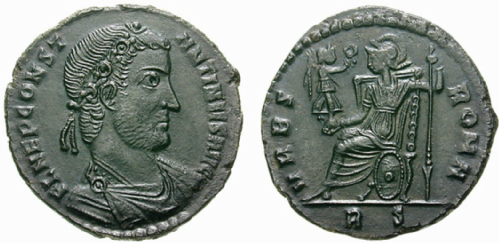 |
Figure 4: Large Æ2 (c. 24mm, 5.36g), usurper Nepotian (AD 350), “Urbs Roma” series (= RIC VIII, Rome 203).
|
|
Figure 5: Large Æ2 (5.05g), usurper Nepotian (AD 350), “Gloria Romanorum” series (= RIC VIII, Rome 200). Numismatik Lanz München, Auction 100, 20.11.2000, lot 581.
As for the reverse, the overall scheme of the type showing a female figure standing front in Fig. 1 is reminiscent of Isis’ common depiction, standing with her body supported on one leg, while brandishing a sistrum (a percussion musical instrument associated with her cult) or a palm branch in her right hand and a situla (a bucket for holy water), sometimes replaced by a patera (a libation bowl), in her left (e.g. Fig. 3). However, the draped figure on the token cannot be identified with the Isis as she lacks a basileion and other attributes which typify the goddess. The objects held by the figure remain difficult to decipher, which could maybe be interpreted as a branch of a not recognizable tree or plant in her right hand and a strip of drapery in her left. Therefore, this precludes to enlighten the precise nature of the reverse motif. Looking at the types belonging to the reverse figurative repertoire of the “Vota Publica” series, the female figure in question appears to be conceptually closer to the depictions of auxiliaries and participants in (Isiac?) religious ceremonies (e.g. torch and candelabra holders, canephores, female attendants, and devotees) (e.g. Fig. 6) than to those of the goddess Isis.
 |
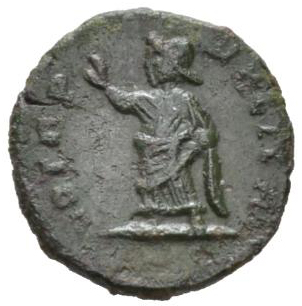 |
Figure 6: Fig. 6: Æ “Vota Publica” token (14mm, 1.41g, 12h). Naville Numismatics 12, 18.01.2015, lot 249. Reference: L. Bricault & C. Mondello, Isis Moneta. The ‘Vota Publica’ tokens from late antique Carthage and Rome (forthcoming), cat. no. I154.4.
Interestingly, this token mixes some features from the “imperial” series (= the depiction of a bust of an alleged Roman emperor or usurper on the obverse) and the “anonymous” one (= the obverse legend “Deo Serapidi”), which were both part of the “Vota Publica” token emission. As recently shown (Bricault & Mondello, forthcoming), the “imperial” series consists of a small first issue from the mint of Carthage dating back to the Second Tetrarchy (AD 305-306) and the Third Tetrarchy (AD 306-307), and a subsequent, large production from the mint of Rome struck from the reign of Constantine I (AD 313-330/331) through at least the first two generations of the Valentinian dynasty (AD 365-378). In contrast, the “anonymous” series is devoid of any chronological reference from which a reliable date can be inferred. Due to die-linkage with some of the Valentinianic groups from the “imperial” series, the “anonymous” series has commonly been regarded as a product of the Roman mint and dated to the years between AD 379-380 and 395, based on some stylistic and historical assumptions (Alföldi 1937, p. 17). However, it remains debated when the production of this undated series began and ended.
If the male portrait on the obverse of the outlined token was indeed intended to represent the usurper Nepotian or was at least borrowed from his official coinage, it may shed light on some aspects of the “anonymous” series manufacture. Among other options, one might consider the token as a trial piece or as part of a transitional group between the “imperial” and “anonymous” series by virtue of its mixed characteristics; or, it could even lead one to consider pre-dating the starting point of the “anonymous” series to AD 350.
However, in this author’s opinion, some remarks on the iconography of the specimen and its historical background may raise serious questions on its genuineness.
Not only are the types occurring on this token unattested, but even certain of their details look anomalous. Regarding the obverse, the anonymous male bust does not constitute a full copy of Nepotian’s coin portrait, as seen above. Rather, the former seems to arise from a re-working of the latter by the engraver, despite the close affinities between them. Noteworthily, the curls on the forehead of the male portrait on the token have a quite unnatural round shape, the appearance of which seems reminiscent of the rosettes forming the imperial diadem often occurring on fourth century Roman coins, including Nepotian’s Roman issues. One might imagine that the die-cutter misrepresented a rosette diadem as a sort of curly fringe when designing the obverse portrait on the token, maybe in an attempt to imitate one of Nepotian’s portraits occurring on the relevant Roman coin dies. In contrast, it seems unlikely that the curly fringe of the male bust’s hair is in fact to be understood as a rosette diadem, due to its position as jutting out on the forehead instead of being placed on the top of the head, as well as given the absence of any diadem’s ties which normally flowed down behind the ruler’s neck on coin imperial portraiture.
Moreover, the obverse of the token deviates from the epigraphic pattern attested on the extant pieces. In fact, the legend DEO SERAPIDI only accompanies the portrait of Serapis, Hermanubis, or even the jugate busts of Serapis and Isis on the obverses of the “anonymous” series, and is never combined with the portrait of a different figure.
Likewise, inconsistencies can also be found on the token’s reverse design. For instance, the right hand of the female figure and the object she bears were drawn as single whole here. As with the obverse type, this “oddity” could also result from an error or misrepresentation by the engraver, who maybe depended on one or other of the variant of Isis holding a palm branch in her right hand, as found on the reverses of the “Vota Publica” tokens. Moreover, it is worth noting that the style of both types has no parallels with any of the surviving “Vota Publica” tokens, which seem to have come out of a different workshop.
Further to these considerations on iconography and style of the token, some aspects related to its expected distribution context also need to be considered. Nepotian’s accession and death dates do not match the date and context in which the “Vota Publica” tokens were supposedly distributed, namely the imperial “public vows” pronounced annually on the 3rd January against the backdrop of the New Year’s festivals. As reported by some late antique literary sources (Descriptio consulum, Eutropius, Jerome, Socrates), Nepotian seized power on 3rd June AD 350 and held it for twenty-eight days until his death, 30 June or 1 July. Therefore, no token could have been issued in the name or with the portrait of this usurper for the public vows on 3rd January in that year or even the following year(s). After all, if one were to consider the possibility that Nepotian’s coin portrait was only used as a model for “Vota Publica” token issue struck at some point since AD 351, cui bono (“to whom is it a benefit”)?
Ultimately, the above analysis suggests that the token may be the result of a counterfeit, most likely made in modern times. Such a forgery may have resulted from the combination of genuine coin image prototypes, which were respectively taken from the Roman coinage of Nepotian (= obverse type) and the “Vota Publica” token series (= reverse type). These images were reworked by the engraver and paired with legends from the “Vota Publica” token series, in order to create an otherwise unknown specimen in an attempt to increase its market value.
We hope that a metallurgical examination of this specimen, currently held in private hands, could be conducted in the near future in order to solve this dilemma.
* Thanks are due to Dr Vincent Drost (Bibliothèque nationale de France, Département des monnaies, médailles et antiques) for suggesting a possible relation between the obverse type of the token discussed here and the coin portraits of the usurper Nepotian.
This blog was written by Cristian Mondello as part of The ‘Vota Publica’ Tokens from Late Antique Rome: Isiac and Egyptian Cults within a Christianizing Roman Empire project, which has received funding from the NRRP, Mission 4, ‘Education and Research’ – Component 2, ‘From Research to Business’ – Investment line 1.2, ‘Funding projects presented by young researchers’ (European Union – NextGenerationEU, proposal no. CFFE1C55, CUP J43C22001030001). The project is hosted at the University of Messina, Italy.
Select Bibliography
- Alföldi A., Isis-szertartások Rómában a negyedik század keresztény császárai alatt = A Festival of Isis in Rome under the Christian Emperors of the IVth Century, Budapest 1937.
- Bricault, L., & Mondello, C., Isis Moneta. The ‘Vota Publica’ Tokens from late antique Carthage and Rome. Volume 1: Catalogue, London (forthcoming).
- Burgess R.W., ‘The Date of Nepotian’s Usurpation’, Historia 72.3, 2023, pp. 370-384.
- RIC VIII = Kent, J.P.C., The Roman Imperial Coinage. The family of Constantine I. A.D. 337–364, Vol. VIII, London 1981.
April 27, 2023
A silver token of Julian in the Ashmolean Museum, Oxford
Among the Roman tokens now in the Heberden Coin Room in the Ashmolean Museum is a silver token made of silver issued by Julian (AD 361-363), the last descendant of the Constantinian dynasty (Fig. 1). On the obverse of the token we find a pearl-diademed, draped, and cuirassed bust of the ruler left, holding Victory on a globe in his right hand and a shield decorated with a she-wolf and twins motif over his left shoulder; although the specimen has a segment broken away from both top and top left hand sides, the obverse legend can confidently be restored as D N FL [CL IVLI-ANVS P F AVG] based on comparison with other known similar token pieces, as will be shown below. On the other side is an image of Anubis standing left, wearing a tunic, a mantle over his shoulders and boots, holding a branch in his right hand and a caduceus in his left, which is accompanied by the legend VOTA [PVB]LICA.
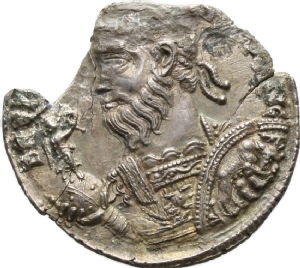 |
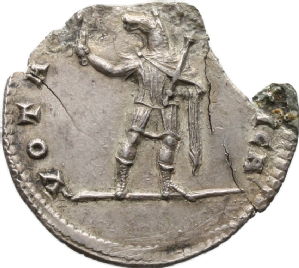 |
Fig. 1: AR, ‘Vota Publica’ token, Rome, AD 361-363 (24mm, 3.45g). Courtesy of the Ashmolean Museum, inv. HCR71367. © Ashmolean Museum.
The imagery and the reverse legend allow us to connect this specimen with a late Roman series, the ‘Vota Publica’ tokens, which were struck by the mint of Rome from the first Tetrarchy (AD 294–305) through at least the first two generations of the Valentinian dynasty (AD 364–378). These tokens display portraits of Roman emperors or Egyptian deities (Serapis, Isis, Hermanubis, or the jugate busts of Serapis and Isis) on the obverse, in conjunction with a variety of depictions referring to different aspects of Egyptian and Isiac cults on the reverse. Although auction catalogues and occasional academic contributions have mostly connected these artefacts to the Navigium Isidis, the renowned festival of Isis which was annually held on the 5th of March, the regular presence of the ‘Vota Publica’ legend as well as the dates of accession and death of imperial rulers that are portrayed on the obverses support instead the idea that these pieces were produced on the occasion of the annual vows (‘vota publica’) collectively pronounced for the health of the Roman emperor on the 3rd of January against the backdrop of New Year celebrations.
The token housed in Oxford, formerly in Prince of Waldeck’s collection (XVIII century), is of great interest not only for the high quality of its designs and workmanship, but also for the metal of which it is made, namely silver. Indeed, the use of silver does deviates from the common patterns seen for the ‘Vota Publica’ tokens, which were normally produced in brass and bronze. This raises questions about manufacturing methods and relevant changes that took place within token production during Julian’s reign.
 |
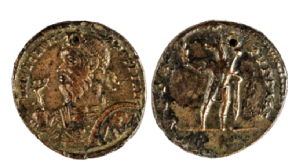 |
Fig. 2: a. AE, ‘Vota Publica’ token, Rome, AD 361-363 (24mm, 4.05g). Numismatica Ars Classica 92, 23-24.05.2016, lot 766. b. AE, ‘Vota Publica’ token, Rome, AD 361-363 (25mm, 6.30g). Courtesy of the Museo Arqueológico Nacional (MAN) of Madrid, inv. 2014/66/67. © Museo Arqueológico Nacional (MAN) of Madrid.
A closer look at the imagery of the token and its relationship to other surviving tokens of Julian from the same series allows us to make some remarks on its chronology and production context. Based on a recent classification of the available material (Bricault & Mondello, forthcoming), Julian’s ‘Vota Publica’ tokens can be sorted into five major groups consisting of die-linked specimens, which were struck in either bronze or brass in three modules, AE1-AE2 (c. 21-27mm) (Julian, Group 1) and AE4 (c. 12–15mm) (Julian, Groups 2–5). Interestingly, Julian’s effigy is shown here according to three variants. Of them, the obverse portrait displayed on the Oxford token is shared by some of the clusters from Group 1 showing different Egyptian images on the reverse (Fig. 2a). Moreover, die analysis shows that the Oxford silver token was issued with the same obverse and reverse dies that were used to strike a specimen made of bronze, now in Madrid (Fig. 2b). The imperial portrait found on these specimens is unparalleled within the official coinage, and was probably an original creation by the Roman mint expressly for the ‘Vota Publica’ series. Two other portraits attested on these tokens instead reproduce or imitate the imperial portraiture found on regular Roman coins: a left–facing and helmeted bust of Julian, holding a shield over his left shoulder (Julian, Group 2) (Fig. 3a), as found on the VOT X MVLT XX silver and bronze coin issues issued at most of the major mints in anticipation of Julian’s decennalia (Fig. 3b); and the common type of the imperial bust right, with cuirass and paludamentum, short or long–bearded (Julian, Groups 1–5) (Fig. 4a), as seen on the small VIRT EXERC ROMANOR bronzes by the Roman mint (RIC VIII, Rome, 327) (Fig. 4b) and, more generally, on solidi and large bronzes issued by other mints in AD 362–363.
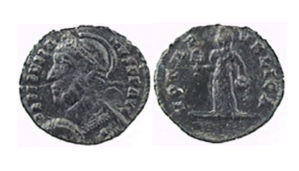 |
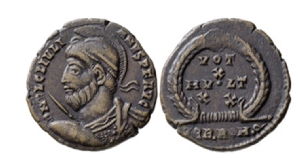 |
Fig. 3 a. AE, ‘Vota Publica’ token, Rome, AD 361-363 (15mm, 1.74g). Courtesy of the Museo Civico di Bologna, inv. 47046. © Museo Civico di Bologna. b. AE, VOT X MVLT XX coin, Rome, AD 363 (18.8mm, 3.17g) (RIC VIII, Rome, 329). Courtesy of the Münzkabinett der Universität Göttingen, inv. AS-04485 © Münzkabinett der Universität Göttingen.
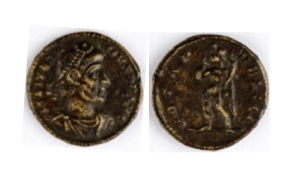 |
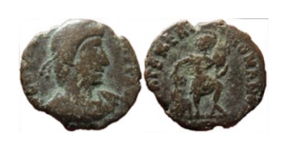 |
Fig. 4 a. AE, ‘Vota Publica’ token, Rome, AD 361-363 (14mm, 1.57g). Courtesy of the Museo Arqueológico Nacional (MAN) of Madrid, inv. 2014/66/203. © Museo Arqueológico Nacional (MAN) of Madrid. b. AE, VIRT EXERC ROMANOR coin, Rome, AD 362-363 (14mm, 1.32g) (RIC VIII, Rome, 327). From a private collection.
The imperial titulature, which reads D N FL CL IVLIANVS P F AVG (Group 1) or FL CL IVLIANVS P F [or P P] AVG (Groups 2–5), along with the comparison with coin imagery allow for a more precise chronology of these token issues. According to Kent, the title D(ominus) N(oster) seems not to have entered general use within Julian’s coinage until after the start of 363 (Kent 1959, p. 114; RIC VIII, pp. 46, 54). Following Kent’s suggestion, the silver token held in Oxford, as well as the large–sized ‘Vota Publica’ tokens from Group 1 bearing a long imperial legend including D N, might date back to the celebrations of the vota publica of the 3rd January 363, as also pointed out by the style of the imperial effigy with a long beard, which clearly refers to Julian’s later coinage. The same dating can be applied to tokens from Group 2, the obverses of which are similar to dies from the VOT X MVLT XX issues apparently struck by the Roman mint in AD 363 (RIC VIII, Rome, 328–330), although the former retained a short imperial titulature not found on the latter. Less clear is instead the chronology of the specimens from Groups 3-5. The portrait and the short imperial legend on the obverse of these pieces, as well as their size - matching the pre–reform VIRT EXERC ROMANOR issues (= AE4) - may date them to the previous year, that is the 3rd January 362, although one cannot completely rule out the idea that they were also part of the AD 363 token issue.
The existence of a ‘Vota Publica’ token made of silver clearly suggests that a small cluster was produced in precious metal within this late Roman series during the reign of Julian, in addition to the more common bronze and brass issues. While the actual purpose of these tokens remains debated (= devices issued as a means of pagan propaganda? Auspicious gifts distributed during New Year celebrations?), it is possible that the choice of manufacturing silver tokens resulted from a more general ‘revival’ of the ‘Vota Publica’ series which took place under Julian. Indeed, the evidence shows that the production of these specimens during the reign of the last Constantinian emperor saw a relative iconographic renewal of the reverse repertoire via the use of a new set of Egyptian types, as well as a reintroduction of the large-module denominations (AE1-AE2), which were earlier only struck for the first ‘Vota Publica’ issues at the time of the first two Tetrarchies (AD 294-305) and then replaced by mostly small-sized denominations (AE4) from Constantine I (AD 313-330/331). Such a ‘revival’ of this token series showing Egyptian religious iconography is not surprising in light of Julian’s religious reform and his (short-lived) attempt to restore Hellenistic polytheism as the state religion. However, this production pattern, based on a trimetallic system (silver, orichalcum, and bronze) for the ‘Vota Publica’ tokens, apparently did not succeed and was not followed by Julian’s successors (Jovian and the Valentinian emperors up to Gratian), who only resumed manufacturing these tokens in brass and bronze – or at least there is no evidence to demonstrate otherwise. Whatever the purpose of these tokens, it may be argued that the use of silver to strike some of Julian’s token issues may have been matched by a higher exchange value compared to that of brass and bronze specimens, which also had the effect of providing a more valuable appearance to the object and the same level of aesthetic quality as found on silver coins and medallions.
This blog was written by Cristian Mondello as part of The ‘Vota Publica’ Tokens from Late Antique Rome: Isiac and Egyptian Cults within a Christianizing Roman Empire project, which has received funding from the NRRP, Mission 4, ‘Education and Research’ – Component 2, ‘From Research to Business’ – Investment line 1.2, ‘Funding projects presented by young researchers’ (European Union – NextGenerationEU, proposal no. CFFE1C55). The project is hosted at the University of Messina, Italy.
Select bibliography
Alföldi A., Isis-szertartások Rómában a negyedik század keresztény császárai alatt = A Festival of Isis in Rome under the Christian Emperors of the IVth Century, Budapest 1937.
Bricault, L., & Mondello, C., Isis Moneta. The ‘Vota Publica’ Tokens from late antique Rome. Volume 1: Catalogue, London (forthcoming).
Kent, J.P.C., ‘An Introduction to the Coinage of Julian the Apostate’ (A.D. 360–3), The Numismatic Chronicle and Journal of the Royal Numismatic Society, 6.19 (1959), pp. 109–117.
RIC VIII = Kent, J.P.C., The Roman Imperial Coinage. The family of Constantine I. A.D. 337–364, Vol. VIII, London 1981.
December 07, 2021
Engraving Roman 'tesserae': the 'Vota Publica' tokens from Girolamo Tanini's collection
Since the sixteenth century, a special and enigmatic late Roman token emission, the ‘Vota Publica’ series, has received attention from antiquarians, dealers and collectors. These tokens, produced in either bronze or brass by the Roman mint, depict the effigies of Roman emperors from Diocletian (AD 284-305) to Valentinian II (AD 375-392) on the obverse (called the ‘imperial’ series). Instead of an imperial image they might also carry the busts of Serapis, Isis, or Hermanubis (or the jugate busts of Serapis and Isis) (called the ‘anonymous’ series). A number of ritual scenes and images referring to different aspects of Egyptian and Isiac cults are shown on the reverses, which are mostly accompanied by the legend ‘Vota Publica’ (= ‘public vows’). Due to the distinctive Egyptian religious iconography of these artefacts, a number of drawings or engravings of the ‘Vota Publica’ tokens appeared in several books, catalogues, and other contributions from the sixteenth to the early twenty centuries. These drawings reproduce, sometimes with a good degree of accuracy, some of the types found in the existing material, although the precise identification of the depicted specimens remains debated in most cases.
Two drawings reproducing ‘Vota Publica’ specimens are known to this author as showing an otherwise unattested obverse-reverse type combination. These designs were included by Girolamo (Hieronymus) Tanini in the plates of his ‘Supplementum’ to Banduri’s volume ‘Numismata Imperatorum Romanorum a Trajano Decio ad Palaelogos Augustos’ (Lutetiae, 1718), which was published in Rome in 1791 (Fig. 1)(Numismatum Imperatorum Romanorum a Trajano Decio ad Constantinum Draconem ab Anselmo Bandurio editorum Supplementum, Romae 1791). In this volume, Tanini catalogued hundreds of gold, silver and bronze coins from the reign of Trajan (AD 98-117) up to until that of Constantine XI Palaiologos (1149-1453). Most of the specimens recorded by Tanini existed as part his own collection, but others came from other collections or were taken from different books and catalogues. Girolamo Tanini was a priest and erudite greatly interested in numismatics, who served in Florence for the Rinuccini family as educator of Marquis Folco Rinuccini’s children Giovanni and Alessandro, as well as curator of the library housed in Palazzo Rinuccini. In this role, Tanini was also in charge of the numismatic collection of the Rinuccini family, which was initiated by Folco’s father, Marquis Carlo Rinuccini (1679-1748).

Fig. 1. Frontispiece of the ‘Supplementum’ by G. Tanini (1791).
In his ‘Supplementum’, Tanini described around seventy ‘Vota Publica’ tokens from both the ‘imperial’ and ‘anonymous’ series, most of which were part of his own collection. However, he only illustrated six of these specimens. Two of them, belonging to the ‘anonymous’ issue, came from Cardinal Stefano Borgia’s collection (1731-1804), and were later acquired by the Vatican. The other four were part of Tanini’s collection.
Of these, two display the pearl-diademed bust of the emperor Jovian facing right on the obverse, accompanied by the legend D N IOVIANVS P F AVG COS, while on the reverse is the type of Isis seated facing on high-backed throne, suckling Horus-Harpocrates (Fig. 2), or the type of Serapis-Agathodaemon and Isis-Thermouthis facing one another, carrying a sacred vase between them from which a serpent emerges (Fig. 3). The tokens depicted in these two drawings, labelled as AE2 (‘secundae formae’), might be identified with two rare specimens bearing the same obverse and reverse type and legend and with the same diameter, which are currently housed in the Vatican collection. The other two drawings provided by Tanini depict the draped bust of Isis facing left on the obverse, wearing a basileion and holding a sistrum in her right hand, while on the reverse is the image of Isis standing right on a galley with oars sailing right. Although these images are widely attested in the available material, none of the surviving specimens show a combination of these two types.
 |
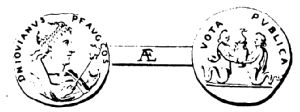 |
| Figure 2: Tanini 1791, p. 324, pl. VI. | Figure 3: Tanini 1791, p. 324, pl. VI. |
In the ‘Supplementum’, Tanini placed these two tokens under the coinage of Helena, the emperor Julian’s wife (died AD 360). As was common in his time, Tanini considered the busts of Serapis and Isis displayed on these tokens as disguised representations of Julian (AD 361-363) and Helena, following the idea that the production of some of these token issues was connected to Julian’s “pagan renaissance”. Tanini’s description of the two considered specimens is as follows:
1) TANINI 1791, p. 321, pl. VI:
Obverse: ‘VOTA PVBLICA (sic). Protome Isidis, vel Helenae, absque velo, cum flore loti, dextrorsum, d. sistrum, s. ad pectus gemmatum composita’.
Reverse: ‘VOTA PVBLICA. Isis sinistrorsum, stans in triremi, utraque manu velum regit’.
The first of the two specimens (Fig. 4) was labelled as AE3 (‘tertiae formae’) by Tanini. While the combination of the illustrated obverse and reverse types, with the legend VOTA PVBLICA occurring on both sides of the token, is not found in any of the known specimens today, it is worth paying attention to a similar specimen from the Vatican collection - Biblioteca Apostolica Vaticana (BAV) inv. no. Mt. Rom. Imp. Helena Iuliani 32. Although in a poor condition, this piece bears the same obverse type and legend as Tanini’s token, and the reverse also looks extremely similar with only one small difference: Isis has turned her head and is looking backwards (left), while on Tanini’s drawing Isis faces forward. It is tempting to assume that the specimen once owned by Tanini matches the Vatican piece, presuming that he misread the reverse type due to the poor condition of the token. However, no data on the acquisition of the piece by the Vatican collection is available. Moreover, the presence of a hole on the Vatican piece, which is not shown in Tanini’s drawing, may make this idea unlikely. If genuine, the piece described and figured in Tanini’s ‘Supplementum’ could provide evidence of an unrecorded ‘Vota Publica’ specimen.
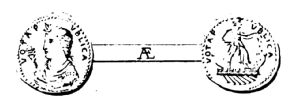 |
 |
| Figure 4: Tanini 1791, p. 321, pl. VI. | Figure 5: Tanini 1791, p. 322, pl. VI. |
2)TANINI 1791, p. 322, pl. VI:
Obverse: ‘DEA ISIS FARIA. Caput Isidis margaritis diadematum, collo duplici margaritarum monili ornato, humeris stolatis, d. sistrum’.
Reverse: ‘VOTA PVBLICA. Isis in triremi, sinistrorsum stans, velum tenet’.
The other specimen illustrated by Tanini (Fig. 5), labelled as A4 (‘quartae formae’), shows the same type combination of the previous piece, but it bears the obverse legend DEA ISIS FARIA instead of VOTA PVBLICA. As the available token specimens show, this legend was never used in the ‘Vota Publica’ series. Moreover, the obverse legend shown in Tanini’s drawing seems to incorporate two of the obverse legends found on the existing pieces with the bust of Isis, namely DE(ae) ISIDI (in the dative case) (Biblioteca Apostolica Vaticana (BAV) (inv. no. Mt. Rom. Imp. Helena Iuliani 30)) and ISIS FARIA (in the nominative case) (Fig. 6). If the piece drawn by Tanini was genuine, the legend DEA ISIS FARIA would be unique (an unicum). Actually, it is likely that the legend transcribed by Tanini was the result of a wrong interpretation. This is despite the fact that Tanini was aware that the legend ISIS FARIA, as well as the less common legend DE ISIDI, occurred on the obverse of the token specimens from the ‘anonymous’ series, as the specimens catalogued in his ‘Supplementum’ demonstrate.

Figure 6: AE, ‘Vota Publica’ token (19mm, 2.30g, 5h). Rome, IV century AD. Bertolami Fine Arts 24, 23.06.2016, lot 955, once part of the Archaeological Museum of Florence’s collection (MAF).
Sadly, the ‘Supplementum’ by Tanini is the only available source for the discussed specimens which, like much of the material published in his volume, are no longer traceable. Indeed, the Tanini collection is currently dispersed. This numismatic collection was incorporated at some point into the Ranuccini collection, which came in 1850 into the Medagliere Granducale of the Reale Galleria in Florence. In turn, the Medagliere Granducale was moved to the Archaeological Museum of Florence (MAF) since 1895. Regrettably, there is no trace of the ‘Vota Publica’ tokens described by Tanini either in the MAF collection or in their registers. As seen above, some of Tanini’s tokens may have been acquired by the Vatican collection at some point in the twentieth century, but the lack of data does not allow us to br certain on this point. Further archival research may hopefully shed light on the fate of the tokens that were once part of Girolamo Tanini’s collection.
This blog was written by Cristian Mondello as part of The creation of tokens in late antiquity. Religious ‘tolerance’ and ‘intolerance’ in the fourth and fifth centuries AD project, which has received funding from the European Union’s Horizon 2020 research and innovation programme under the Marie Skłodowska-Curie grant agreement No 840737.
Select Bibliography
- A. Alföldi, Isis-szertartások Rómában a negyedik század keresztény császárai alatt = A Festival of Isis in Rome under the Christian Emperors of the IVth Century, Budapest 1937.
- G. Capecchi et al., Palazzo Peruzzi. Palazzo Rinuccini, Rome 1980.
- H. Tanini, Numismatum Imperatorum Romanorum a Trajano Decio ad Constantinum Draconem ab Anselmo Bandurio editorum Supplementum, Romae 1791.
May 01, 2021
A Flavian token in the Hunterian Museum, Glasgow
Writing about web page https://coins.warwick.ac.uk/token-specimens/id/hunterian.RLT24
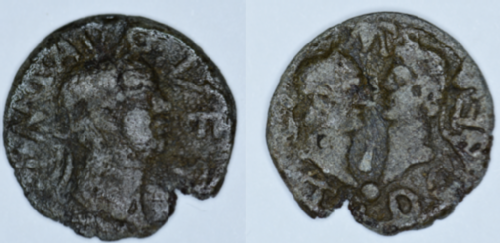
Lead token, 19mm, 12h, 2.74g. Side a: Laureate head of Vespasian right; IMP AVG VES around. Side b: Laureate heads of Titus (on left) and Domitian (on right) facing each other; IMP above and T DO CAES below.
TURS 40, The Hunterian Museum, RLT 24. Photo by author.
Amongst the Roman lead tokens now in the Hunterian Museum in Glasgow is a piece that presents the Flavian dynasty. On one side of the token we find a portrait of the emperor Vespasian, accompanied by a legend that names him. On the other side we find his sons, Titus and Domitian, facing each other with a globe between them. The token recalls coinage that was struck in Vespasian's name in AD 70 (RIC II.12 Vespasian 15–16, 37). An example of this coinage is shown below.

Silver denarius, 7.5mm, 6h, 3.22g. Obverse: Laureate head of Vespasian right, IMP CAESAR VESPASIANVS AVG around. Reverse: Bare head of Titus on left facing bare head of Domitian on right, CAESAR AVG F COS CAESAR AVG F PR around.
RIC II.12 16, American Numismatic Society 1944.100.39897.
At first glance, the coin and token are very similar: both show Vespasian on one side and his sons on the other, with accompanying legends naming the individuals shown. But upon closer examination there are also important differences. On the token both Titus and Domitian are shown wearing laurel wreaths ("laureate"); one can see the ties of the wreaths flowing down behind their respective necks. On the coin they are bare-headed. On the token a globe is placed between the busts, absent on the coin issue. This globe, and the representation of Vespasian's sons, recalls an earlier token issue showing the twin sons of Drusus the Younger, Tiberius Gemellus and Tiberius Germanicus, shown below.

Orichalcum token, 21mm, 4.67g, 12h. Obverse: Two young busts facing each other, each with a star above (the twin sons of Drusus the Younger), globe in between them. Reverse: VIIII within dotted border within wreath.
Buttrey B19/VIIII, © The Trustees of the British Museum, R. 4456.
The IMP on the token (an abbreviation of the title imperator) sits above the heads of Titus and Domitian. Who the title refers to is ambiguous; it may refer only to Titus, but since both Titus and Domitian are laureate it perhaps references both of them. Both Titus and Domitian also had the title CAESAR, abbreviated to CAES on the token and placed on the right hand side. In sum, although the token was likely inspired by the coin type, the makers did not merely copy the coin. They adapted the 'official' image and altered it; the resulting tokens were presumably given to an audience who were receptive to the alterations.
The precise occasion that motivated the creation of this token series is not known. It might have been created in connection to Vespasian's triumph (an important moment in which the new Flavian dynasty was presented to Rome), or at some later occasion. Another token issue also shows the laureate heads of Titus and Domitian, this time without the globe (TURS 41-42). On the other side of this token issue we find a horse rider carrying a spear accompanied by the legend IMP AV VES. The reference to Vespasian suggests that it is the emperor shown on horseback here. Whatever the occasion for the tokens showing laureate Titus and Domitian, their existence provides us with an insight into a particular vision of the Flavian dynasty not found on coinage or other media. This particular imagery of the imperial family would have contributed to the emotions, experiences and memories of the events in which the tokens were used.
This month's blog was written by Clare Rowan, as part of the Token Communities in the Ancient Mediterranean Project.
September 01, 2020
The lead tokens of Roman Egypt: Thoughts on function
Based upon the work of J. G. Milne, lead tokens in Roman Egypt are thought to be an unofficial coinage. Milne came to this conclusion because, when he analysed the Roman coins from Oxyrhynchus’ rubbish dumps, he noticed that there were fewer bronze coins present for the period AD 180 – 260 (Milne 1908; Milne 1922). He thought that the lead tokens replaced the lower denomination bronze. The Oxyrhynchite tokens depicting Athena are not, however, standardised as would be expected for even a pseudo-coinage. It is also apparent that lead tokens were in use in Roman Egypt before the period AD 180 – 260, as evidenced by an example bearing the image and name of Messalina, and a series of tokens found at Abydos dating to the first century BC. Despite his awareness of these examples, Milne still took a broad-brush approach to his interpretation that tokens were low denomination coins. It is therefore worth exploring other possibilities for the ways in which tokens could have functioned in the province.
Milne’s theory regarding the use of tokens as a low denominational coinage is not totally unfounded, as there are a small quantity of tokens that indicate a denomination. These include those with the legend ‘OBOΛOI B’ (‘two obols’, see figure 2) from Tebtunis and the Serapeum at Saqqara, as well as a specimen in the Ashmolean collection with the legend ‘ΔIOB’ (‘diob[ol]’, see figure 1. It is also possible that the I is instead a Φ that has become worn. If this is the case, then the inscription cannot refer to a diobol). These are, however, in the minority in comparison to hundreds of other specimens that do not bear a denominational mark, which suggests that this was not an extensive issue of tokens. The thin flans of the examples from Tebtunis also suggest that they were impractical for everyday use, and so may not have been intended for quotidian circulation.
  |
Figure 1: Token possibly naming the denomination diobol. Obverse: Wreath, within which ΔIOB(?); solid line border. Reverse: Egyptian style altar(?); solid line border. Metal: Lead. Diameter: 26mm. Weight: 7.12g. Die axis: 12. Ashmolean Museum, Milne 5441. Image: Ashmolean Museum.
The paucity of tokens bearing a denomination, alongside the impracticality of the Tebtunis issues, suggests that another possibility is worth exploring. It is feasible that these tokens were intended to represent the given amount, without actually holding this worth or circulating as a coin. A lead token series from Rome refers to 1000 sestertii, but it seems unlikely it would have been worth that amount (TURS 1460). A modern parallel is the ‘Hell money’ used today in Asia, which while having the appearance of a banknote, exhibit denominations running into the millions. It is offered to the ancestors and not accepted as legal tender (Scott 2007, 26-28). Although these examples have a much higher denominations than on those found on the tokens from Roman Egypt, they demonstrate that a denomination does not necessarily indicate an all-purpose coin. This point is particularly pertinent as a token of the ‘OBOΛOI B’ type was found at the Serapeum of Saqqara at Memphis. When this token, and others bearing the ethnic ‘MEMΦΙC’ (Memphis), were studied by Longperier in the nineteenth century he posited that they could be religious coins used exclusively at Memphis (Longperier 1861, 411). He states that Pausanias references the use of a ‘local coin’ as a votive offering at Memphis (Pausanias Description of Greece 7.22, 3-4; Longperier 1861, 412). Pausanius implies that the coins were copper, which does obviously not fit the description of the lead tokens. The nome coinage of Roman Egypt displays imagery relevant to each of the nome districts and could perhaps fit this description, however, this was struck at Alexandria and so was ‘local’ to a questionable extent. The fact that ‘local coins’ were important for votive offering at Memphis does, however, leave open the possibility that the lead tokens fulfilled this need. A ‘coin’ created specifically as a votive offering can feasibly be encompassed within the term ‘token’.
 |
Figure 2: : Token from Tebtunis. Obverse: Apis bull facing right, with solar disc between horns, to left Isis(?) standing right wearing solar disc and to right janiform figure(?) standing left and holding uraeus serpent. Crescent and garland above in field; border of dots. Reverse: Nilus sitting left, holding cornucopia in left hand and reeds in right, Alexandria-Euthenia standing before him holding ear of corn aloft in right hand; border of dots; OBOΛOI B. Metal: Lead. Diameter: 30mm. Die axis: 12. Image: Milne 1900, pl XXVI, fig 1.
Others have posited that some of the lead tokens were tax receipts (Rostovtzeff and Prou 1900, 151-152; Mitchiner 1984). Some tokens bear the legend ΕΠ ΑΓΑΘW, which has been translated to mean ‘interest payable upon wealth’ (Mitchiner 1984, 113). However, tax receipts are known from papyrological evidence in Roman Egypt, so it seems unlikely they would take the form of tokens as well. There are also many instances in the ancient world where the phrase means ‘good fortune’, such as this inscription on a marble column drum from Lepcis Magna. The phrase is also found on rings in the Roman period (Le Blant 1896, 90; Ogden 1990, 109). Given that tokens in the ancient world are likely to have been used for euergetic distributions, this phrase would not be out of place on such tokens.
A group of tokens that are unprovenanced within Egypt can also offer an alternative function. They depict Athena on one side (unconnected to the Athena tokens from Oxyrhynchus) and have the legend ΑΓΟ (‘AGO…’, see figure 3) on the other face. It is likely that the legend refers to the agoranomoi, who oversaw markets in the Greek world. Tokens with similar legends – ΑΓ (AG…), ΑΓΟΡ (AGOR…) and ΑΓΟΡΟΝΟΜΩΝ (AGORANOMON) - have also been discovered in the Athenian agora. A possibility for their use that they were issued as proof of payment to sacrificial banquets organised by the agoranomoi (Bubelis 2013, 125). This is also plausible for Roman Egypt, as a papyrus from Karanis dating to the early third century AD also provides a link between religious banquets and their organisation by the agoranomoi (P.Mich. 8511).
 |
Figure 3: Token possibly referring to the agoranomoi. Obverse: Athena standing left, wearing Corinthian helmet, left hand resting on shield at feet to right, outstretched left hand holding Nike with wreath and palm; solid line border. Reverse: AΓO; solid line border. Metal: Lead. Diameter: 24mm. Weight: 9.98g. Die axis: 12. Köln, Institut für Altertumskunde accession no. AL_3560. Image: Köln, Institut für Altertumskunde.
The instances highlighted above are only a minority of the tokens found in Roman Egypt, however, they provide alternative suggestions for utilisation other than a low denomination coinage, and emphasise how tokens could have a variety of functions within the province.
This blog is written by Denise Wilding. The content of this blog is adapted from: Wilding, D. 2020. Tokens and Communities in the Roman Provinces: An Exploration of Egypt, Gaul and Britain. Unpublished PhD thesis, The University of Warwick.
With thanks to the Humanities Research Fund, University of Warwick for their support.
Bibliography
Blant, E. Le. 1986. 750 Inscriptions de pierres gravées inédites ou peu connues. Paris: Imprimerie Nationale.
Bubelis, W. 2013. “The Agorastikon of Hellenistic Athens: Not a Market-Tax.” Zeitschrift für papyrologie und epigraphik 185: 122–26.
Longperier, A. 1861. “Monnaies du Sérapéum de Memphis. Trouvaille de Myt-Rahinch.” Revue Numismatique VI: 1–24.
Milne, J. G. 1908. “The Leaden Token Coinage of Egypt under the Romans.” The Numismatic Chronicle and Journal of the Royal Numismatic Society 8: 287–310.
Milne, J. G. 1922. “The Coins from Oxyrhynchus.” The Journal of Egyptian Archaeology 8: 158–63.
Mitchiner, M. 1984. “Imperial Portrait Tesserae from the City of Rome and Imperial Tax Tokens from the Province of Egypt.” The Numismatic Chronicle 144: 95–114.
Ogden, J. M. 1990. “Gold Jewellery in Ptolemaic, Roman and Byzantine Egypt.” Unpublished PhD thesis, University of Durham. http://etheses.dur.ac.uk/1457/.
Pausanias, Description of Greece, trans. W. H. S. Jones. 1918. London: Heinemann.
Rostovtzeff, M., and M. Prou. 1900. Catalogue Des Plombs de l’antiquité, Du Moyen Age et Des Temps Modernes Conservés Au Département Des Médailles et Antiques de La Bibliothèque Nationale. Paris: Rollin et Feuardent.
Scott, J. L. 2007. For Gods, Ghosts and Ancestors: The Chinese Tradition of Paper Offerings. Hong Kong: Hong Kong University Press.
August 17, 2020
Lead Tokens depicting Athena from Roman Oxyrhynchus
The result of our excavations showed that I had been so far right in that the rubbish mounds were nothing but rubbish mounds; and the miscellaneous small anticas which we found are of little interest…
Grenfell 1896-1897, 3.
Oxyrhynchus, the ‘city of the sharp-nosed fish’, is situated in the Fayum of Egypt. Originally an Egyptian city that was colonised by the Greeks, it continued to thrive under the Romans. Today is best known for the reams of Ptolemaic and Roman papyri discovered in its rubbish heaps by Grenfell and Hunt in the late nineteenth and early twentieth centuries. There is, however, more to Oxyrhynchus than its papyri, and after more than a hundred years some of the so-called ‘miscellaneous small anticas’ deserve reassessment.
Amongst the artefacts of which Grenfell was so disparaging, are around three hundred lead tokens, dating to the Roman period (Milne 1922, 159). These small, unassuming objects, often worn and with traces of their designs barely discernible, are largely ignored in modern scholarship. A series of papers published in the early 20th century by J. G. Milne focused on identifying the types, and posited that they functioned as a low-denomination token coinage. How tokens were used in Roman Egypt still remains uncertain, but analysis of their iconography can move beyond identification of types.
Milne rightly noted that different series of tokens were present at Oxyrhynchus (Milne 1908, 297). Some have imagery similar to the Alexandrian coinage, depicting for instance deities such as Serapis or Nilus. Like Alexandrian coins, tokens often have a date in regnal years which is signified by an ‘L’ before the numerals in Greek. Unlike coins, tokens in Roman Egypt don’t bear the portrait of the emperor, and so it is usually unclear to whose reign this date refers. Tokens of this series are found on other sites in Egypt, such as Antinoopolis, Karanis and elsewhere in the Fayum, as well as just outside of Egypt at Qasr Ibrim and in a shipwreck off Israel’s Carmel coast.
In contrast, another series of tokens appears to have local significance to Oxyrhynchus. These all feature the goddess Athena on one face. Most frequently it is her bust that is depicted (Figure 1) but she also appears fighting a serpent (Figure 2), and sometimes her cult statue features within a temple. Most tokens pair her with Nike on the reverse, aside from a small subset on which Zeus is depicted seated (Figure 2).
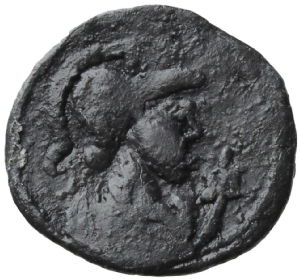 |
 |
Figure 1: Token depicting Athena with labrys. Obverse: Bust of Athena-Thoeris right, wearing Corinthian helmet, labrys to front. Solid line border. Reverse: Nike advancing left, holding wreath in right hand and palm in left hand; ΟΞ. Solid line border. Metal: Lead. Diameter: 20mm. Weight: 3.34g. Die axis: 11. Ashmolean Museum, Milne 5302. Image: Ashmolean Museum.
Despite the variation in the manner of her depiction, there is clearly a preference for tokens featuring Athena at Oxyrhynchus; Milne identified the goddess on 184 tokens out of a total of 271. This frequency is further emphasised by the fact that the Oxyrhynchite Athena types are not found anywhere else in Egypt (Milne 1908, 297. This still holds true based on the data available today, which includes discoveries made after Milne’s study.). The presence of the Greek legend ‘ΟΞ’ (OX) on some of the Athena tokens also clearly refers to the first two letters of Oxyrhynchus. This legend works alongside the imagery to emphasise the distinct local character of this type of token.
The uniqueness of these tokens to Oxyrhynchus is further exemplified by the choice of attribute for Athena on the tokens: the labrys, or double-headed axe. It is present on types where she is depicted attacking a serpent and also alongside her bust. The labrys is an unusual attribute for Athena. It does not feature alongside her on many depictions from antiquity, aside from one representation from Mycenae, the nome coinage of Οxyrhynchus, possibly on a terracotta lamp from Οxyrhynchus, and perhaps as part of a statue of Athena found at Οxyrhynchus (LIMC II, Athena no. 2; LIMC II, Athena no. 27; RPC III 6355-6358; British Museum OA.11020;Mathiopoulos 2001, 202-217 for the statue, who posists that the statue’s missing attribute is a cornucopia. However, a labrys is also a possibility, given the association of Athena with this attribute at Oxrhynchus).
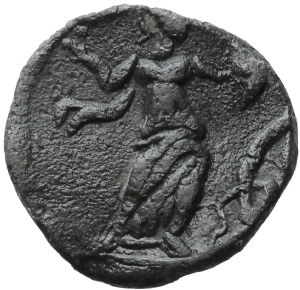 |
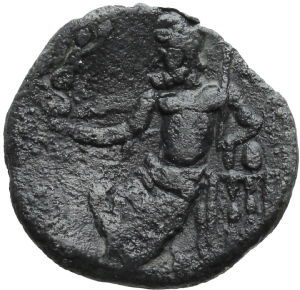 |
Figure 2: Token depicting Athena fighting serpent. Obverse: Athena-Thoeris advancing right, holding labrys in right hand and shield in left, attacking serpent before her. Reverse: Zeus seated left, in right hand holding Nike right with wreath, and in left hand holding sceptre. Metal: Lead. Diameter: 23mm. Weight: 7.88g. Die axis: 11. Ashmolean Museum, Milne 5304. Image: Ashmolean Museum.
In terms of the significance of the labrys to the town, current scholarship does not appear to have reached a definitive conclusion. In her study of the double-headed axe, Kouremenos states in reference to the nome coinage of Οxyrhynchus that it might be associated with workmen in the city that used the double axe as a woodworking tool (Kouremenos 2016, 47). Others have interpreted the presence of the labrys on the nome coinage as an ‘Egyptian’ emblem, due to the fact that in art it was often depicted with the Egyptian god Tutu, in which context it has been interpreted as an apotropaic symbol (Weber and Geissen 2013, 168). Its association with Athena at Οxyrhynchus might be viewed as acknowledging her role as a protective guardian goddess of the town, while also amalgamating Egyptian and Greek elements (Weber and Geissen 2013, 168). The labrys is, however, found frequently in Greek and Roman art (Kouremenos 2016, 43-50 for overview). In this regard, it appears in many places in different contexts, similar to the manner in which the imagery of Athena is common. It is, however, only when Athena and the labrys appear together in the specific context of the material culture of Οxyrhynchus that they are able to transform into a new image which becomes associated with the locality.
 |
Figure 3: Coin of Hadrian (nome coinage). Obverse: laureate bust of Hadrian, right; border of dots; ΑΥΤ ΚΑΙ ΤΡΑΙ ΑΔΡΙΑ CΕΒ. Reverse: Athena standing facing, head left, wearing Corinthian helmet, holding labrys in left hand and Nike in extended right hand; border of dots; ΟΞΥΡ/ LΙΑ. Metal: Bronze. Weight: 4.70g. Mint: Alexandria. Date: AD 117-138. RPC III 6357. Ashmolean Museum Accession no. HCR34309. Image: Ashmolean Museum.
The unusual pairing of Athena with the labrys at Οxyrhynchus was not her sole distinction from the ubiquitous Athena of the classical world. From numerous references in the town’s papyri, it is evident that Athena was equated with, or given the epithet of, the goddess Thoeris. There are references to ‘worshippers of the cult of Athena-Thoeris’, the ‘temple of Athena-Thoeris’ and the ‘place of the temple of Athena-Thoeris’, amongst others (P.Oxy. 3.579; P.Rein. 2.93; P.Oxy. 34.2722; P.Oxy. 50.3567). To some extent perhaps the goddesses were perceived as separate: one document refers to ‘the temple of Athena and Thoeris’ (P.Oxy. 10.1268).
Thoeris is the Greek name for the Egyptian goddess Taweret. She took the form of a hippopotamus, and her worship had become prominent at Οxyrhynchus from the late Ptolemaic period (Whitehorne 1995, 3080-82). The reason for the connection of Athena to Thoeris/Taweret in not clear, but it is perhaps because each goddess was associated with childbirth and fertility (Whitehorne 1995, 3080-82). In ancient Egypt Taweret was associated with the protection of women and children. Inscribed magical knives from the Middle Kingdom period bear apotropaic figures and texts indicating that they were for the protection of women and children, and most frequently feature Taweret as the apotropaic figure (Weingarten 1991, 4: 45 out of the 58 published knives feature Taweret). From the New Kingdom, jugs in the form of Taweret were used for the pouring of libations from a hole in one of the jug’s breasts, indicating an association with childbirth and breastfeeding mothers (Bruyère 1939, 104-107). Athena’s link to women and motherhood is less explicit, but it is perhaps her capacity as a protector that syncretises her with Taweret.
 |
Figure 4: A faience amulet depicting the Egyptian goddess Taweret. 332-30 BC. The Metropolitan Museum of Art, accession no. 26.7.888. Creative Commons CC0 1.0 Universal Public Domain Dedication.
Despite the outwardly classical style of Athena on these tokens, these syncretisms should be taken into account. The Athena depicted on these tokens’ had associations with Thoeris, and her Egyptian counterpart Taweret, which lent a particular local context to the way in which the imagery may have been viewed and read by the community of Οxyrhynchus. Veronique Dasen has also reached similar conclusions in her analysis of a gem depicting Athena attacking a serpent with a labrys, which bears the inscription ‘Thoeris’ (Dasen 2019). She considers how the imagery of the gem could have been read on both Greek and Egyptian terms due to the iconography evoking all three goddesses.
The choice to depict Athena in classical form underlines the creation of tokens in a Graeco-Roman milieu, especially as Taweret was concurrently worshipped independently at local shrines and certain populations would have recognised her Egyptian guise. This does not, however, discount the possibility that those who used and viewed tokens interpreted the image on their own terms and read different combinations of Athena, Thoeris and Taweret.
Blog written by Denise Wilding, The University of Warwick.
The content of this blog is adapted from: Wilding, D. 2020. Tokens and Communities in the Roman Provinces: An Exploration of Egypt, Gaul and Britain. Unpublished PhD thesis, The University of Warwick. With thanks to the Humanities Research Fund, University of Warwick for their support.
Bibliography
Bruyère, B. 1939. Rapport Sur Les Fouilles de Deir-El-Médineh, 1934-35. Cairo: l’Institut Français d’Archéologie Orientale.
Dasen, V. 2019. “One God May Hide Another. Magical Gems in a Cross-Cultural Context.” In Magical Gems in Their Context, Proceedings of the International Workshop Held at the Museum of Fine Arts, Budapest 16–18 February 2012, edited by K. Endreffy, Á.M. Nagy, and J. Spier, 47–58. Rome: L’Erma Di Bretschneider.
Grenfell, B. P. 1896-1897. “Oxyrhynchus and Its Papyri.” Archaeological Report (Egypt Exploration Fund) 1896-1897: 1–12.
Kouremenos, A. 2016. “The Double Axe (Λάβρυς) in Roman Crete and beyond: The Iconography of a Multi-Faceted Symbol.” In Roman Crete: New Perspectives, edited by J. E. Francis and A. Kouremenos, 43–58. Oxford: Oxbow Books.
Mathiopoulos, E. 2001. “On the Transformation of the Athena Velletri Type in Hellenistic Alexandria.” In Athena in the Classical World, edited by S Deacy and A. Villing, 197–218. Leiden: Brill.
Milne, J. G. 1908. “The Leaden Token Coinage of Egypt under the Romans.” The Numismatic Chronicle and Journal of the Royal Numismatic Society 8: 287–310.
Milne, J. G. 1922. “The Coins from Oxyrhynchus.” The Journal of Egyptian Archaeology 8: 158–63.
Weber, M., and A. Geissen. 2013. Die Alexandrinischen Gaumünzen Der Römischen Kaiserzeit. Die Ägyptischen Gaue Und Ihre Ortsgötter Im Spiegel Der Numismatischen Quellen. Wiesbaden: Otto Harrassowitz.
Weingarten, J. 1991. The Transformation of the Egyptian Taweret into the Minoan Genius: A Study in Cultural Transmission in the Bronze Age. Partille: Aström Forlag.
Whitehorne, J. 1995. “The Pagan Cults of Roman Oxyrhynchus.” Aufsteig Und Neidergang Der Romischen Welt II (18.5): 3050–91.
June 01, 2020
Frederick Parkes Weber and the Bowl of Coins Prize
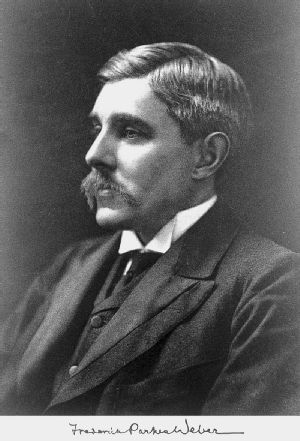 |
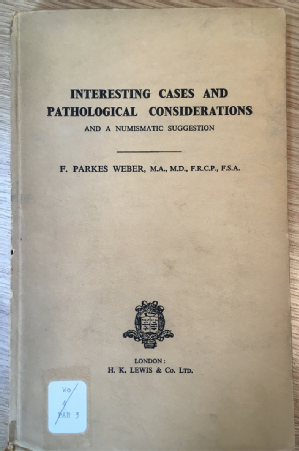 |
|
Frederick Parkes Weber,
|
Interesting Cases and Pathological
Considerations.
|
Amongst the papers of the famous dermatologist Frederick Parkes Weber now housed in the department of Coins and Medals in the British Museum is a book rather intriguingly entitled Interesting Cases and Pathological Considerations and a Numismatic Suggestion. While most of the book will not interest the student of coinage, the ‘numismatic suggestion’ appended at the end provides a great insight into Weber’s knowledge of ancient coinage (he was an avid coin collector) and the Royal Numismatic Society’s Parkes Weber Prize, currently awarded to the best essay ‘of not more than 5,000 words on any subject relating to coins, medals, medallions, tokens or paper money’ written by someone under 30.
The numismatic suggestion (photographs of the text available to read here and here) records that originally Parkes Weber proposed to the Royal Numismatic Society (RNS) an annual ‘bowl of coins’ prize. The idea came to him since, as a collector, he had to frequently quickly assess bowls of coins from various dealers across the world. The council found the suggestion impractical, and so instead implemented the prize in its current form. But it appears that Parkes Weber was not happy with the solution, and so published his original letter of 1st October 1953 to the President of the Royal Numismatic Society ‘in the hope that at some future time my suggestion will be carried out by a society of private donor. I believe that a small analogous prize is being offered to postage stamp enthusiasts with considerable success.’
Reading the letter, Parkes Weber originally proposed to the RNS an annual prize of 10 guineas to young collectors for ‘the best written diagnosis (with half an hour) of the contents of a bowl of miscellaneous coins and coin-like objects (twenty pieces in the bowl) under the supervision of a delegate of the Society in question’. He suggests they should all be good or moderately good specimens, as well as one or two imitations. He then goes on to offer detailed advice on what this ‘bowl of coins’ should contain.
Parkes Weber suggested the bowl should contain two or three counters or admission tickets (e.g. the Nürnberg Rechenpfennige, the card counters struck on the accession of Queen Victoria with the Duke of Cumberland on horseback on the reverse). He also suggests the inclusion of Greek and Roman tokens, including the so-called spintriae. These tokens carry sexual imagery on one side and a number on the other: Parkes-Weber includes the now discounted idea they were used as brothel admission tickets. He then notes that a fellow collector gave him two spintriae because the collector ‘did not like having them in his collection, when he was showing it to ladies’. Two bronze Roman tokens from the Parkes Weber collection are now in the British Museum, although only one shows an erotic scene.
 |
|
'Spintria' in the British Museum once owned by Parkes Weber.
The obverse shows a scene of sexual intercourse and the reverse
carries the number III within a wreath. © The Trustees of
the British Museum, 1906,1103.2927.
|
Parkes Weber writes that only five of the twenty coins in the bowl should be of very rare or obscure types, and suggests specific coin types for ‘occasional admission to the bowl’. These include a copper coin of the Seljukian Turks with types copied from Byzantine Christian pieces, a coin of Edessa ‘preferably a coin of Count Baldwin II with the slashing horseman reminding one of the Norman knights on the Bayeux tapestry’, a coin weight of Charles I struck by Briot, school tokens of the seventeenth century, the ‘dolphin coins’ of Olbia, medieval and modern badges, and Russian beard tokens and prison tokens. Reading the list, one is struck by the interest and knowledge Parkes Weber had of tokens from all ages.
There is, despite the publication of the letter (admittedly in a venue which may not be frequently read by numismatists) still no ‘bowl of coins’ prize. But it does make one think about what types of coins and money might make up the bowl today!
This blog was written by Clare Rowan as part of the Token Communities in the Ancient Mediterranean project.
May 01, 2020
Casting Roman tokens: Notes on two unpublished token moulds from Florence collections
Whilst the interest in token moulds has mostly been confined to excavation reports and occasional enquiries to date, recent scholarship is increasingly focusing on the value of these objects to better understand crucial aspects related to the manufacturing techniques, production location and use of tokens in antiquity (cf. Pardini et al. 2016; Rowan 2019). Lately, token moulds are also gaining attention on the market and in auction sales.
Two unpublished token moulds are presented below, which exist as part of two museum collections from Florence, Italy. Both token moulds are discussed in a study currently being undertaken by the author.
The token mould shown on Fig. 1 is held in the Museo Archeologico of Firenze (MAF) (inv. no. 79209). It is one half of a mould made of limestone, rectangular in shape, whose size is 115 x 80 x 27 mm. It would have been used in conjunction with the other half (now lost) in order to create 8 circular tokens of about 16-17mm in diameter.
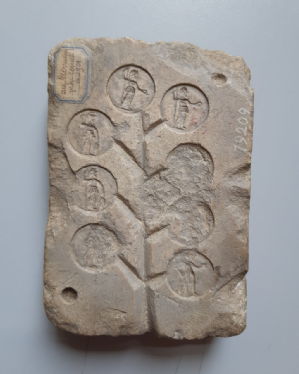 |
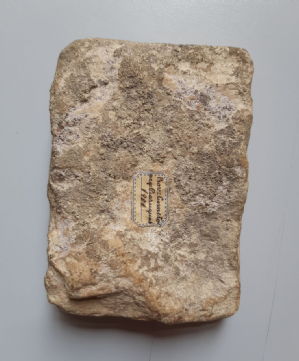 |
Figure 1: Roman token mould from Museo Archeologico Nazionale of Firenze (MAF) (inv. no. 79209) (Courtesy of the MAF).
Based on the designs engraved on the surface – but some of them are unfortunately in poor condition – the resulting tokens carried at least three different types of images: on the left side, two of the preserved designs show Mars, helmeted, in military dress, standing right, holding spear in right hand and resting left on shield on ground (the type is also applied to Minerva, who is generally portrayed with a longer robe); on the top, two token cavities depict Mars helmeted, in military dress, standing right, holding spear in right hand and patera in left hand; in the lower right corner, a token design shows Hercules standing right, holding scyphum in left hand and club in right hand. These images are variants of types commonly depicted on Roman lead tokens, as already known through the examples published by M. Rostowzew as well as on individual catalogues of museum collections (for some of the types in question, see e.g. Rostowzew and Prou 1900, 135, fig. 32; Arzone and Marinello 2019, nos. 108-111 and 113). It is noteworthy that the first of the two images of Mars mentioned above appears on the tokens produced at the time of Nero, and was adopted on official coinage just afterwards, occurring on the coins issued during the Civil Wars of AD 68-69 (Fig. 2). However, the designs attested on the MAF mould are closer to the variant of a Mars type largely found on coinage from the time of Trajan (Fig. 3) up to the fourth century, which allows us at least to date the token mould to this broad time frame. To support this, morphological and stylistic features, as well as the material used, are consistent with the token molds from Rome and Ostia, generally assigned to the period between the 1st and 3rd centuries AD.

Figure 2: Silver denarius, RIC 12 Civil Wars 20, AD 68-69. (UBS Gold & Numismatics, Auction 83, lot 183).
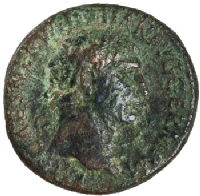 |
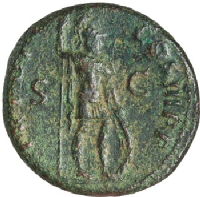 |
Figure 3: Bronze As of Trajan, Rome AD 99-100 (= RIC II, Trajan 410), American Numismatic Society (inv. no. 0000.999.18549)
This token mould is said to have been found in Corneto Tarquinia (Lazio), whose ancient site was one of the most important settlements of the twelve Etruscan cities (the ‘Dodecapolis’), and which was under Roman domination since the third century BC. This place does not appear among the sites documented as find spots of token moulds to date, which have been found in Rome and Ostia, except for two examples from Como and Telesia (Rowan 2019, 98-99). If one accepts as reliable the information on its place of discovery, this mould specimen might suggest that a local production of lead tokens existed in Tarquinia in the imperial period. Moreover, it has recently been assumed that a ‘distributed production’ rather than a centralized single workshop was the common ‘model’ for the manufacture of tokens over the Roman period, which would have been created ‘in multiple places by multiple individuals’ (cf. Rowan 2019, 97).
This piece was sold to the MAF on 10 May 1901 by the collector and member of the Accademia Colombaria Anton Domenico Pierrugues, who donated his collection of Greek and Roman coins to the museum after his death (1915).
 |
 |
Figure 4:Roman token mould from Casa Buonarroti, Florence (Lenzini Moriondo’s inventory (1964), 22/1) (Courtesy of Casa Buonarroti).
Fig. 4 illustrates one half of a token mould housed at Casa Buonarroti, whose collection was formed from the 16th to the 19th century from the bequest of Michelangelo Buonarroti and his descendants. The piece is made of limestone, quadrangular in shape, and is 83 x 76 (min. 73) x 28 mm in size. The other half of the artefact is lost also in this case. The mould would have created seven circular tokens of 14-15 mm in diameter, which were decorated with the image of the Three Graces on one side. This depiction is a popular type on Roman lead tokens. A bronze uniface Roman token (14mm, 2.90g) showing the Three Graces on one side while blank on the other side exists as part of the Casa Buonarroti collection. The iconography and size of this token perfectly match the token cavities of the mould, making it likely that the bronze tessera was cast through the mould in question (Figs. 5-6). Anyway, it is likely that this bronze token was a product of a sample casting from the mould after its discovery. This might be suggested by the absence of remains of casting sprues on the token specimen as well as by its uniface appearance, since it is highly probable that the other half of the mould containing casting branches to the cavities was also decorated (see below). However, no data is available about the place of discovery of the mould, and it is not possible to determine when precisely in modern times the tessera was cast.
 |
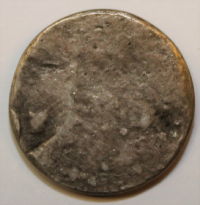 |
|
Figs. 5-6: AE Roman token (14mm, 2.90g), Casa Buonarroti, Florence.
The mould has a remarkable resemblance to a token mould of palombino marble with the same designs (105 x 75 mm for 7 circular tokens of ca. 17 mm) published by Cesano (1904, 11, fig. 1), which was found in the 19th century in Rome during the Lungotevere works. Such close ties might hint that the Casa Buonarroti mould came from Rome. According to ongoing research by the author, the mould may have been part of the inheritance of the antiquarian and senator Filippo Buonarroti (1661-1733), the great-grandnephew of Michelangelo Buonarroti, who stayed in Rome over the years ca. 1684-1699 serving as secretary, conservator of collections and librarian of the influential family of Cardinal Gasparo di Carpegna. In Rome, Filippo Buonarroti led a number of archaeological explorations which allowed him not only to assemble an impressive collection of Roman and Etruscan antiquities, but also to conduct pioneering studies in ancient iconography, epigraphy, and numismatics.
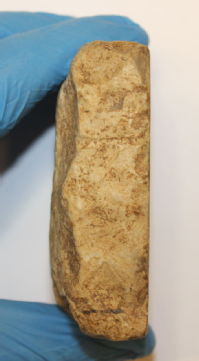 |
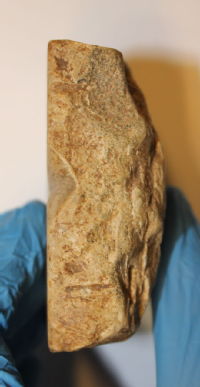 |
Figs. 7-8: Top and bottom sides of the mould from Casa Buonarroti, Florence.
Both token moulds show morphological and technical features which are largely documented for this class of objects. The extant half of the MAF mould shows a ‘herringbone’ arrangement, with a central casting channel with branches leading to the individual token moulds. The piece from Casa Buonarroti has instead only a central casting channel and no ‘branches’; one should assume that the now lost other half of the mould contained the channels through which molten lead was poured into the token cavities. In the top right and lower left corners, both molds bear the holes of the nails which were used to fasten both halves of the mould together, but also to ensure that they were correctly aligned (cf. Rowan 2019, 95). Furthermore, all four sides of the token mould from Casa Buonarroti carry small grooves which, as has been argued, would be suggestive of the use of wire which wrapped around the molds during the casting process (cf. Pardini et al. 2016) (Figs. 7-8). Also, as with a token mould from the Harvard Art Museums discussed by Rowan, a deep central hole is found in the center of each token cavity of the Casa Buonarroti mould, being visible in the guise of a protuberance on the body of one of the Graces in the resulting token, as is attested on the extant bronze tessera from Casa Buonarroti. This depression would be a clue of the method employed for engraving the token designs, since it would have been caused by the bit of a tool used for cutting the circular depressions before the designs were engraved. Finally, the back of both mold specimens is unworked, as attested on many moulds of this type.
Further analysis and the potential discovery of new specimens could help develop future discussion on the ancient token moulds, thus providing a more complete picture about the production and use of tokens in the ancient world.
 |
This blog was written by Cristian Mondello as part of The creation of tokens in late antiquity. Religious ‘tolerance’ and ‘intolerance’ in the fourth and fifth centuries AD project, which has received funding from the European Union’s Horizon 2020 research and innovation programme under the Marie Skłodowska-Curie grant agreement No 840737.
Select bibliography
A. Arzone and A. Marinello, Museo di Castelvecchio. Lead Tokens. Tessere di piombo (Modena, 2019).
L. Cesano, ‘Matrici e tessere di piombo nel Museo Nazionale Romano’, NSc. (1904), 11-17.
G. Pardini, M. Piacentini, A.C. Felici, M.L. Santarelli, and S. Santucci, ‘Matrici per tessere plumbee dalle pendici nord-orientali del Palatino. Nota Preliminare’, in A.F. Ferrandes and G. Pardini (eds), Le regole del gioco. Tracce, archeologi, racconti. Studi in onore di Clementina Panella (Rome, 2016), 649-667.
U. Procacci, La Casa Buonarroti a Firenze (Firenze, 1965).
M. Rostowzew, Tesserarum urbis Romae et suburbi (St. Peterburg, 1903).
M. Rostowzew and M. Prou, Catalogue des plombs de l’antiquité (Paris, 1900).
C. Rowan, ‘A Roman token mould in Harvard’, Coins at Warwick Blog.
C. Rowan, ‘Lead token moulds from Rome and Ostia’, in N. Crisà, M. Gkikaki, and C. Rowan (eds), Tokens. Culture, Connections, Communities (London, 2019), 95-110.
October 01, 2019
Hortensia Sperata, Token Issuer in Rome or Ostia
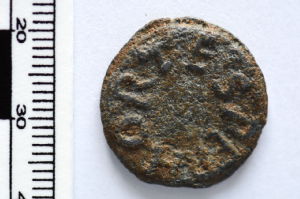 |
 |
Lead token from Rome or Ostia, now in the The Bibliothèque nationale de France in Paris (Rostowzew and Prou 422a). 12h, 20mm, 4.13g, TURS 1241.
Side A: HORTE SPER around in a circle.
Side B: Palm branch within a wreath.
Pictured above is a lead token, which, from the style of its design and its fabric, we can assign either to the city of Rome or to Ostia. What is remarkable about this piece is that the token carries the name of a Roman woman: Horte(nsia) Sper(ata). Her name circles around the edge of one side of the token in a way very similar to Roman coinage. The other side carries imagery commonly found on lead tokens in this region: a wreath and palm branch. These communicate to the user a festive, happy atmosphere.
This was not the only token that Hortensia issued. Another token carries her name in full: HORTENSIA SPERATA, with the same design (palm branch within wreath) on the other (TURS 1240). Two further tokens are smaller in diameter (13-15mm) and seem to carry an abbreviation of her name: HOR on one side and SPE or SP on the other (TURS 1242, 1243). Why would Hortensia have so many variant tokens? She might have wished to have two sizes of token (20mm and 13-15mm), with one perhaps worth more than the other, or with each representing different products or levels of access. An engraver could have created a mould for her tokens that cast both sizes at once, a practice known from other surviving examples.
 |
The palombino marble mould pictured here would have been utilised to make tokens during the Roman imperial period. It was found along with several others on the Esquiline Hill in Rome in 1882. Here we can find another individual responsible for tokens, whose name has been abbreviated to LVE (a practice also commonly found in graffiti). Like the tokens of Hortensia, we can see that LVE wanted two sizes of token: a larger and a smaller piece. On the smaller piece his initials have become ligate: i.e. they have been joined together ti fit into the reduced size. In a similar way Hortensia's name was abbreviated on her smaller tokens.
We do not know anything more about Hortensia Sperata, but one presumes she had a certain amount of wealth. From the men and women named on Roman lead tokens, some were magistrates in government or colleges; others appear to be linked to bath houses. Whatever the specific use of these tokens (and it is very hard to be certain), they were likely used in an act of patronage: the provision of necessary small change, for example, the sponsoring of a banquet or other event, or a distribution. The lead tokens of Rome and Ostia reveal a world otherwise unrecorded in our sources, where both men and women utilised these objects to cement personal relationships and consolidate local communities.
This coin of the month blog was written by Clare Rowan as part of the ERC-funded Token Communities in the Ancient Mediterranean Project.
July 01, 2019
The 'man with the shovel' on the 'plomos monetiformes' of Baetica

A lead token from the 'series de las minas'.
Obverse: a naked man walking left, a shovel marked PRVM on his shoulder, holding out a bell. P S to either side; wreath border.
Reverse: Naked man standing right pouring water from an askos onto a beribboned phallus; broom below on exergual line, Q. CO ILLI Q around and LVSO in a tablet in the exergue; wreath border.
Stannard PC 25. American Numismatic Society, New York, Richard B. Witschonke Collection. Ex CNG 31, 9 September 1994, lot 1857 Casariego 1987, p. 26, no. 1, Carbone 2018 pl. 29 no. 3.
In Spain there exist large (45-50mm) struck lead monetiform pieces whose precise function remains elusive. Many of the pieces are decorated with the design shown on the specimen above: a naked man carrying a 'shovel'. Because of this image they were traditionally believed to be monetary pieces associated with mining in the region - the naked man was interpreted as a miner. But the figure looks very different to known representations of Roman miners, and Stannard has demonstrated that this figure (and other images) are actually shared between Baetica (Spain) and central Italy, appearing on monetiform objects in both regions. It is thus not a miner - but who is it? Stannard (1995) suggested the figure might be associated with agriculture (a farmer going off to work with a shovel, shown watering his plants on the other side) or with Italian theatre, since often the figure is shown with an overly large phallus.
 |
|
Close up of the 'man carrying a shovel' inscribed with PRVM
or PRVNA and carrying a bell. (Stannard et al. 2017 fig. 25).
|
Many other pieces connected to this series show imagery related to the baths or the palaestra, and it perhaps in this context that we should seek clues as to the identity of our individual. As briefly mentioned by Stannard et al. (2017), the figure should likely be understood as a fornacator, the individual responsible for stoking the fires in the bath house to get the water warm. These individuals can be shown as naked and ithyphallic, as seen in the mosaic shown below. Our 'naked man with shovel' also holds a bell in his right hand, a variation only found in Baetica and not in Italy. This is likely a reference to the bell or gong that was rung by bath houses to announce that the water had reached the optimum temperature - so come take your bath now! This practice is referenced by several ancient authors and a bell was found in 1548 in the baths of Diocletian in Rome bearing the inscription FIRMI BALNEATORIS. A gong, uncovered in the Palaestra of the Stabian baths of Pompeii, probably served a similar function; bells might also be rung to indicate that the baths were soon closing and now was the last opportunity for a bath (Nielsen 1990, 111). If the fornacator was responsible for making sure the water was at the right temperature, then it would make sense that he is depicted with the bell that was rung when the temperature for bathing was perfect. Having identified the individual as a stoker of fires, we might return to the legend inscribed on the man's shovel: PRVM. I wonder if the legend might actually be PRVNA, the Latin term for glowing charcoal, with the N and A ligate (joined together). The figure on the other side of this lead piece, puring water from a vessel, may be a slave attending a master in the bath complex or bath attendant.
 |
 |
| Mosaic from Thamugadi showing a fornacator (stoker). (Nielson 1990) | Plomo monetiforme showing an ithyphallic man with shovel. Stannard PC no. 29 |
Are these pieces then bathing tokens? Stannard et al. 2017 argue they are not, since images related to bathing in this series are connected with other imagery that is not connected to the baths at all; some specimens also carry value marks, which suggests they had a monetary function. Lead tokens found in bath complexes in Italy, however, (e.g. in Fregellae and in Ostia), do not necessarily carry 'bathing' imagery; a wide variety of images may have been used in this particular sphere (just as mosaics in Roman bath houses are not all necessarily related to the activity of bathing). Those in Fregellae also appear to carry value marks. The alternative is that an image of a low-ranking bath worker should be chosen as an image for a pseudo-coinage, or a monetary series commemorating an act of euergetism related to the baths (as suggested by Stannard et al. 2017). This possibility is an intriguing one; hopefully future work will offer us further information in this regard!
This blog post was written by Clare Rowan as part of the Token Communities in the Ancient Mediterranean project.
Bibliography:
Carbone, L. (2018). The unpublished Iberian lead tokens in the Richard B. Witschonke collection at the American Numismatic Society. American Journal of Numismatics 30: 131-144.
Casariego, A., G. Cores and F. Pliego (1987). Catálogo de plomos monetiformes de la Hispania Antigua. Madrid.
García-Bellido, M. P. (1986). Nuevos documentos sobre minería y agricultura romanas en Hispania. Archivo español de arqueologia 59: 13-42.
Nielsen, I. (1990). Thermae et Balnea (2 vols). Aarhus, Aarhus University Press.
Spagnoli, E. (2017). Un nucleo di piombi 'monetiformi' da Ostia, Terme dei Cisiarii (II.II.3): problematiche interpretative e quadro di circolazione. Per un contributo di storia economica e di archeologia della produzione tra II e III secolo d.C. Annali dell'Instituto Italiano di Numismatica 63: 179-234.
Stannard, C. (1995). Iconographic parallels between the local coinages of central Italy and Baetica in the first century BC. Acta Numismàtica 25: 47-97.
Stannard, C., A. G. Sinner, N. Moncunill Martí and J. Ferrer i Jané (2017). A plomo monetiforme from the Iberian settlement of Cerro Lucena (Enguera, Valencia) with a north-eastern Iberian legend, and the Italo-baetican series. Journal of Archaeological Numismatics: 59-106.
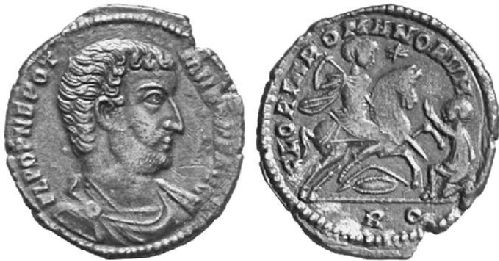
 Clare Rowan
Clare Rowan

 Please wait - comments are loading
Please wait - comments are loading
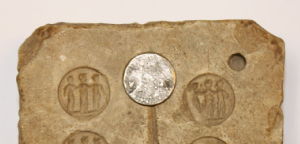

 Loading…
Loading…

